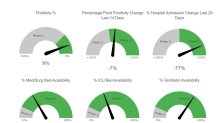
According to publicly available metrics, the state of Illinois is currently within range of moving into Phase Four of its phased reopening plan later this month.
Later this week, Illinois will hit the halfway point of Phase Three, with a June 26 date to potentially move to Phase Four still on the table.
There are three key metrics that each of the four healthcare regions in the state must hit in order to be eligible to move into Phase Four of the plan. The region must have a positivity rate below 20 percent, and it cannot see an increase of more than 10 percentage points over a 14-day period.
Regions must also avoid an overall increase in hospital admissions for COVID-19-like illnesses for a 28-day period, and regions must have surge capacity for at least a 14 percent increase in ICU beds, medical and surgical beds, and ventilators in order to move forward.
As of Monday, all four of Illinois’ healthcare regions are well within the parameters of all three of those metrics, including the Northeast region, which has been hardest hit by the coronavirus. The region’s current positivity rate is at nine percent, with a seven percent decline in that number over the last 14 days.
The region has also seen a significant drop in hospital admissions over the last 28 days, and is still doing well in surge bed availability, ICU bed availability, and ventilator availability:

In terms of the other three regions in the state, all are doing even better than the Northeast region, with every region at five percent or below in terms of positivity rate and all well within the margin for hospitalizations, ICU bed availability and ventilator availability, according to the latest numbers from state officials.
Local
The two areas that are still in doubt for moving forward into Phase Four are testing, which must be available regardless of symptoms or risk factors, and contact tracing, which must be performed within 24 hours of diagnosis for more than 90 percent of new cases in a region in order to move forward.
Testing is still becoming more widely available, as many centers are now allowing tests regardless of whether a patient is showing symptoms, but contact tracing will need to be stepped up in order for each region to move forward.
Illinois Gov. J.B. Pritzker has made contact testing a priority in his administration, which is working on ramping up the program throughout the state.



